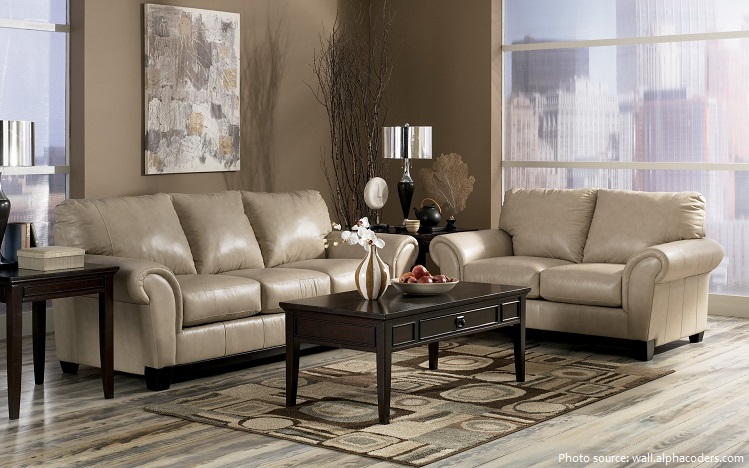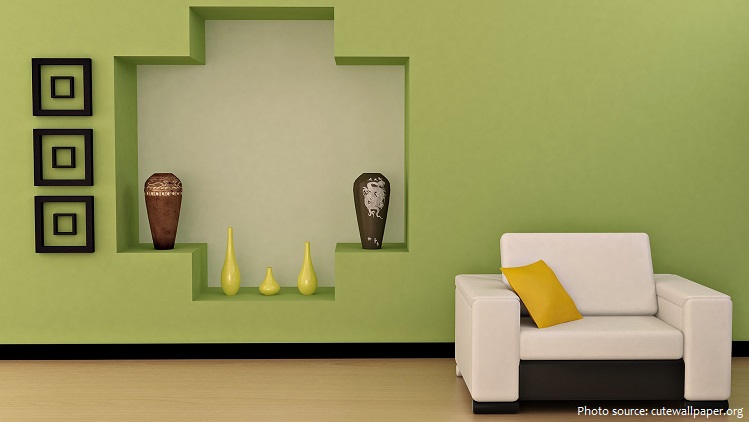
Furniture refers to movable objects intended to support various human activities such as seating (e.g., chairs, stools, and sofas), eating (tables), and sleeping (e.g., beds).
The English word “furniture” is derived from the French word fourniture, the noun form of fournir, which means to supply or provide. Thus fourniture in French means supplies or provisions. The English usage, referring specifically to household objects, is specific to that language – French and other Romance languages as well as German use variants of the word meubles, which derives from Latin mobilia, meaning “moveable goods”.
The practice of using natural objects as rudimentary pieces of furniture likely dates to the beginning of human civilization. Early humans are likely to have used tree stumps as seats, rocks as rudimentary tables, and mossy areas for sleeping.

During the late palaeolithic or early neolithic period, from around 30,000 years ago, people began constructing and carving their own furniture, using wood, stone and animal bones. The earliest evidence for the existence of constructed furniture is a Venus figurine found at the Gagarino site in Russia, which depicts the goddess in a sitting position, on a throne. A similar statue of a seated woman was found in Catal Huyuk in Turkey, dating to between 6000 and 5500 BC. The inclusion of such a seat in the figurines implies that these were already common artefacts of that age.
Ancient furniture was made of many different materials, including reeds, wood, stone, metals, straws, and ivory. Some civilizations inlay or carved images of mythological creatures or constellations carved into their furniture. The chairs would be stylized with metals, finials, inlays, or upholstery. It was a common practice for the legs of furniture to be shaped like animal legs and use mortise and tenon joints. Lacquerware and Ivory carving were also common. Throughout the ancient world inlay were common. Metals such as bronze or gold. Sometimes furniture would be inlaid into a certain shape. For example, the game Mehen was played on a table inlaid into the shape of a snake. Inlays were also used to ornament shapes.

Beds, stools, throne chairs, and boxes were the chief forms of furniture in ancient Egypt. Although only a few important examples of actual furniture survive, stone carvings, fresco paintings, and models made as funerary offerings present rich documentary evidence.
In Europe, some of the earliest known furniture comes from a stone-age village at Sara Brae in the Orkney Islands in Scotland about 2,000 BC. The stone age farmers lived in stone huts with roofs of whalebone and turf. Inside they made stone furniture such as cupboards and beds.
Ancient Greek furniture was typically constructed out of wood, though it might also be made of stone or metal, such as bronze, iron, gold, and silver. Historical knowledge of Greek furniture is derived from various sources, including literature, terracotta, sculptures, statuettes, and painted vases.

The modern word “throne” is derived from the ancient Greek thronos, which was a seat designated for deities or individuals of high status or honor.
Roman furniture was based heavily on Greek furniture, in style and construction. Rome gradually superseded Greece as the foremost culture of Europe, leading eventually to Greece becoming a province of Rome in 146 BC. Rome thus took over production and distribution of Greek furniture, and the boundary between the two is blurred. The Romans did have some limited innovation outside of Greek influence, and styles distinctly their own.
In contrast to the ancient civilizations of Egypt, Greece, and Rome, there is comparatively little evidence of furniture from the 5th to the 15th century. Very few extant pieces survive, and evidence in literature is also scarce. It is likely that the style of furniture prevalent in late antiquity persisted throughout the middle ages.

Along with the other arts, the Italian Renaissance of the 14th and 15th century marked a rebirth in design, often inspired by the Greco-Roman tradition. A similar explosion of design, and renaissance of culture in
general occurred in Northern Europe, starting in the fifteenth century.
The 17th century, in both Southern and Northern Europe, was characterized by opulent, often gilded Baroque designs that frequently incorporated a profusion of vegetal and scrolling ornament. Starting in the 18th century, furniture designs began to develop more rapidly.
Between the years of 1801-1900, furniture was very artistic and detailed. Gothic styles were popular and chairs often had fancy cut-out designs. The intricate designed chairs were often used by the wealthy at dinners.

Early North American furniture dates to the early 20th century in America, furniture was more basic and made of necessity versus fancy artistic and detailed designs – basic dressers for storage and simplistic chairs and stools for sitting, were often made of woods such as cherry or walnut as they were easily bent with a steaming process.
In post World War II , simple, sleek furniture designs were influenced by artists and designers with roots in Germany (Marcel Breuer), France (Eileen Gray), Spain (Lilly Reich) and Japan (Isamu Noguchi) – chairs representing basic seating needs in combination with artistic designs became very popular in this era.

Ecodesign can be traced back to the 1920’s, in America, when people became somewhat aware of the toll some materials can take on the environment though it‘s popularity did not blossom until the 1960‘s – furniture in Ecodesign is increasingly popular in modern days as it uses resources that are quickly grown and replaced such as bamboo, bamboo tables are popular examples of Ecodesign furniture used for holding items, without draining Earth‘s resources.
Contemporary furniture refers to all modern or recent furniture designs – from the 1970’s onward – from all over the world, aluminum and iron furniture are popular materials used in sleek and geometric contemporary designs – iron kitchen/dining room tables are amongst the most popular styles.

The bed may have been the earliest form of furniture- it was constructed of wood and consisted of a simple framework supported on four legs. A flax cord, plaited, was lashed to the sides of the framework. The cords were woven together from opposite sides of the framework to form a springy surface for the sleeper.
The Dragons chair was made by the Irish designer called Eileen Gray in 1971 for the auction at Christie and was sold at the high price of $27.8 million. This chair is made from the pure brown leather and further
enhanced with the wooden frame to complete its look. It was considered as the perfect symbol of strength for the people to protect them. It is the most expensive chair in the whole world.
The word “table” is derived from Old English tabele, derived from the Latin word tabula – “a board, plank, flat top piece”.
Television is considered furniture because it qualifies the fact that furniture is movable objects. It can be moved from one place to another, from one corner of the house to the other.